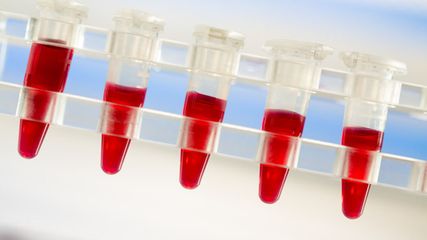<p class="article-intro">The term “liquid biopsy” means accessing tumor DNA through a blood sampling, without the need of an invasive tissue biopsy. Plasma cell-free DNA (cfDNA) is an easily accessible source of tumor DNA that allows accurate profiling of lymphoma patients, representing a complementary source of tumor DNA to tissue biopsy for genotyping. Applications of cfDNA analysis in lymphomas include: i) identification of tumor mutations in a biopsy-free manner; ii) tracking tumor clonal evolution and identification of mutations causing resistance to treatment; and iii) monitoring of residual disease after therapy.</p>
<p class="article-content"><div id="keypoints"> <h2>Keypoints</h2> <ul> <li>ctDNA is an easily accessible source of tumor DNA in lymphoma patients.</li> <li>ctDNA analysis is possible and the capability to identify lymphoma-associated mutations is already confirmed by published data.</li> <li>ctDNA can be used to monitor MRD in aggressive B-cell lymphomas.</li> </ul> </div> <h2>Tumor genotyping on circulating tumor DNA</h2> <p>Tumor genotyping of lymphomas lacking a leukemic phase has so far relied on the analysis of the diagnostic tissue biopsy. However, multiregional sequencing showed that the diagnostic tissue biopsy might be subject to a selection bias resulting from spatial heterogeneity and, therefore, might not be representative of the entire tumor genetics.1 Circulating tumor DNA (ctDNA) is representative of the entire lymphoma heterogeneity, thus allowing to bypass the bias imposed by tissue biopsies in the reconstruction of the entire cancer clonal architecture, and to identify resistant clones that are dormant in non-accessible tumor sites. Accessing the blood stream has also clear sampling advantage in the serial monitoring of treatment emergent resistant mutations in real time.<sup>2</sup> <br />Independent studies have assessed the sensitivity and specificity of targeted gene mutations analysis in ctDNA vs. tumor biopsy as gold standard from untreated diffuse large B-cell lymphoma (DLBCL) patients by using Cancer Personalized Profiling by Deep Sequencing (CAPP-seq) method (Fig. 1).<sup>3–5</sup> The recovery rate of confirmed mutations (i. e. true positive rate) in the tumor biopsy ranges from 95 % to 99 %. The biopsy-confirmed mutations missed in ctDNA (i. e. false negative rate) range from 1 % to 5 % and are mostly of low allelic abundance in the tumor. CAPP-seq of ctDNA thus stands as a robust and validated technology for accurate DLBCL genotyping. Genotyping of ctDNA by CAPP-seq allows recovering of 100 % of tumor biopsy-confirmed actionable mutations of DLBCL, and longitudinal monitoring in blood the emergence of ibrutinib-resistance mutations.<sup>3–6</sup> These data support the implementation in the clinic of this non-invasive technique in both settings. CAPP-seq standardization is however required before bringing this test in the diagnostic routine of DLBCL (Fig. 1). <br />CtDNA is an alternative source of tumor DNA when representation of lymphoma cells is insufficient in the tissue biopsy, like in classic Hodgkin lymphoma (cHL).<sup>7, 8</sup> The rarity of neoplastic Hodgkin and Reed-Sternberg cells in the biopsies is a limit to the genetic characterization of cHL. By CAPP-seq, biopsy-confirmed tumor mutations are detectable in ctDNA samples with a true positive rate of 87 % in cHL patients.<sup>7</sup> Though still far from clinical applications, CAPP-seq of ctDNA opens the opportunity of genotyping of large cohorts of cHL patients for the identification of genetic prognostic biomarkers and, within clinical trials, for the identification of biomarkers predictive of response to treatment.</p> <p><img src="/custom/img/files/files_datafiles_data_Zeitungen_2019_Leading Opinions_Onko_1904_Weblinks_lo_onko_1904_s13_fig1_rossi_spina.jpg" alt="" width="550" height="442" /></p> <h2>Minimal residual disease (MRD) monitoring on circulating tumor DNA in DLBCL</h2> <p>Due to the lack of a leukemic dissemination, MRD monitoring has been so far limited in tissue-born lymphomas without bone marrow (BM) involvement, as DLBCL. <br />The proof of principle that minimal residual disease can be monitored by using plasma as source of cell-free DNA has been recently provided. Next-generation sequencing methods relied on either the VDJ sequences from the immunoglobulin receptors or the mutational profile as tumor fingerprints to be dynamically quantified for MRD estimation (Fig. 1). <br />Two independent studies tracked the VDJ sequences from the immunoglobulin in cfDNA by using deep sequencing in DLBCL. Both studies showed a tumor marker detection rate of ∼ 85 % in tumor biopsies and 82 % to 92 % in pretreatment ctDNA.<sup>9, 10</sup> Levels of ctDNA correlated with other measures of tumor burden, including lactate dehydrogenase, metabolic tumor volume, and International Prognostic Index. Furthermore, they suggested a prognostic role for monitoring ctDNA during and after therapy. In patients achieving an initial CR, ctDNA was detectable 3 to 3.5 months before clinical relapse, outperforming positron emission tomography/ computed tomography (PET/CT).<sup>9, 10</sup> In addition, patients with undetectable ctDNA on the first day of cycle 3 of therapy had a superior PFS (but not overall survival) compared with patients with positive ctDNA.<sup>9</sup> Despite its value as a prognostic tool, tracking VDJ sequences from the immunoglobulin has several shortcomings. This includes limited sensitivity in low tumor burden settings and reduced applicability because of SHM, leading to difficulty identifying clonotypic sequences.<br /> To overcome some of these challenges, CAPP-seq deep sequencing, has been developed to track MRD in DLBCL.<sup>5, 11, 12</sup> In the CAPP-seq approach, the tumor marker is represented by the composition of tumor somatic alterations. This approach allows to detect a tumor biomarker alteration in up to 100 % of pretreatment ctDNA samples. Pretreatment ctDNA levels correlate with clinical measures of tumor burden. Changes of ctDNA load during treatment correlated with patient outcome (Fig. 2). Relapses could be noninvasively detected in 100 % of cases with a mean lead time exceeding 6 months.<sup>3, 5</sup></p> <p><img src="/custom/img/files/files_datafiles_data_Zeitungen_2019_Leading Opinions_Onko_1904_Weblinks_lo_onko_1904_s13_fig2_rossi_spina.jpg" alt="" width="820" height="395" /></p> <h2>Minimal residual disease (MRD) monitoring on circulating tumor DNA in cHL</h2> <p>Limited access to the tumor material from the tissue biopsy has hampered the development of molecular prognostic and predictive factors in classical Hodgkin lymphoma (cHL), a frequent and clinically heterogeneous mature B-cell tumor whose stratification represents an unmet medical need. The rarity (usually < 5 %) of tumor cells (Hodgkin and Reed-Sternberg cells) in the lymph node biopsies involved by cHL, and their routine FFPE preservation, impose major technical hurdles and the identification of genetic features for disease monitoring and response assessment is challenging in this disease. In a large study conducted by highly sensitive next-generation sequencing method, lymphoma-specific immunoglobulin gene segments have been identified in cHL at initial diagnosis or recurrence, and assessed the ability of detecting such lymphoma-specific sequences in peripheral blood.<sup>13</sup> Furthermore, pivotal evidence suggests that the use of ctDNA for tumor genotyping may allow to bypass such technical issues in cHL.<sup>14</sup> In our recent study we established ctDNA as an alternative and accessible source of tumor DNA for cHL genotyping.<sup>7</sup> CtDNA levels rapidly changed during chemotherapy, with a > 100-fold decrease after two cycles in patients with responsive disease. Hence, ctDNA levels complemented interim PET/ CT and may allow a more accurate outcome prediction (Fig. 2). Our results suggest that ctDNA is a novel tool for real-time genotyping and a potential precision medicine biomarker in cHL.<sup>7</sup></p> <h2>Conclusions</h2> <p>The liquid biopsy approach has a great potential for the detection and surveillance of disease relapse, and many choices for the quantitation of mutations or VDJ rearrangements in circulating tumor DNA are currently available (Fig. 1). Despite the fact that many of these techniques have been developed as valuable noninvasive, appropriate, and real-time monitoring tools, none of these techniques has been translated yet into the clinical practice. Undoubtedly, future studies to investigate whether monitoring of ctDNA can be used to improve clinical outcomes for patients with aggressive B-cell lymphomas are warranted. New opportunities that go beyond assessment of VDJ recombination are also being explored, and ultrasensitive assays that can assess for genotypic tumor DNA in the blood are under development as well.<sup>3, 4, 10, 11</sup> Quantification of ctDNA coupled with PET/CT improves the accuracy of residual disease assessment at the interim time compared to the sole PET/CT in both DLBCL and cHL (Fig. 2). Molecular monitoring of ctDNA holds tremendous promise and may be a transformative tool for monitoring therapy in aggressive B-cell lymphomas.</p></p>
<p class="article-footer">
<a class="literatur" data-toggle="collapse" href="#collapseLiteratur" aria-expanded="false" aria-controls="collapseLiteratur" >Literatur</a>
<div class="collapse" id="collapseLiteratur">
<p><strong>1</strong> Gerlinger M et al.: Intratumor heterogeneity and branched evolution revealed by multiregion sequencing. N Engl J Med 2012; 366: 883-92 <strong>2</strong> Diaz LA Jr, Bardelli A: Liquid biopsies: genotyping circulating tumor DNA. J Clin Oncol 2014; 32(6): 579-86 <strong>3</strong> Rossi D et al.: Diffuse large B-cell lymphoma genotyping on the liquid biopsy. Blood 2017; 129: 1947-57 <strong>4</strong> Scherer F et al.: Non invasive genotyping and assessment of treatment response in diffuse large B cell lymphoma. Blood 2015; 126(23): 114 <strong>5</strong> Scherer F et al.: Distinct biological subtypes and patterns of genome evolution in lymphoma revealed by circulating tumor DNA. Sci Transl Med 2016; 8(364): 364ra155 <strong>6</strong> Scherer F et al.: Noninvasive detection of ibrutinib resistance in non-Hodgkin lymphoma using cellfree DNA. Blood 2016; 128: 1752 <strong>7</strong> Spina V et al.: Circulating tumor DNA reveals genetics, clonal evolution and residual disease in classical Hodgkin lymphoma. Blood 2018; 131(22): 2413-25 <strong>8</strong> Camus V et al.: Detection and prognostic value of recurrent exportin 1 mutations in tumor and cell-free circulating DNA of patients with classical Hodgkin lymphoma. Haematologica 2016; 101(9): 1094-101 <strong>9</strong> Roschewski M et al.: Circulating tumour DNA and CT monitoring in patients with untreated diffuse large B-cell lymphoma: a correlative biomarker study. Lancet Oncol 2015; 16(5): 541-9 <strong>10</strong> Kurtz DM et al.: Noninvasive monitoring of diffuse large B-cell lymphoma by immunoglobulin high-throughput sequencing. Blood 2015; 125(24): 3679-87 <strong>11</strong> Newman AM et al.: An ultrasensitive method for quantitating circulating tumor DNA with broad patient coverage. Nat Med 2014; 20(5): 548-54 <strong>12</strong> Newman AM et al.: Integrated digital error suppression for improved detection of circulating tumor DNA. Nat Biotechnol 2016; 34(5): 547-55 <strong>13</strong> Herrera AF et al.: Next generation sequencing-based detection of circulating tumour DNA after allogeneic stem cell transplantation for lymphoma. Br J Haematol 2016; 175(5): 841-50 <strong>14</strong> Schmitt MW et al.: Detection of ultra-rare mutations by next-generation sequencing. Proc Natl Acad Sci USA 2012; 109(36): 14508-13</p>
</div>
</p>



